This section explains how to set up the resource database that the cluster resource management facility (CRM) manages.
Set up the CRM resource database according to the following procedure:
Initial setup
Set up the resource database that CRM manages.
Automatic configure
Register the connected hardware devices (shared disks, line switching units, and network interface cards) to the resource database that CRM manages.
Note
You can check the NIC (network interface card) to be registered by executing the "ifconfig(1M)" command in the plumb up state.
Set up the CRM resource database from the CRM main window. Use the CRM main window as follows:
Operation procedure
Select PRIMECLUSTER -> Global Cluster Services -> Cluster Admin in the Web-Based Admin View operation menu.
When the "Cluster Admin" screen is displayed, select the crm tab.
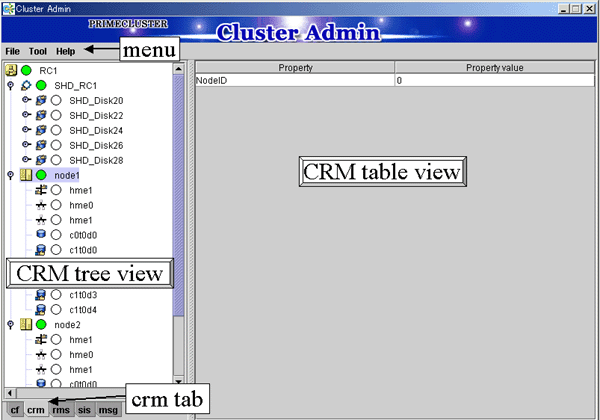
The areas shown in the screen are described below.
This area displays the menu. See "7.1.2.1.3 Operations".
This area displays the resources registered to CRM. The resources are displayed in a tree structure.
For details on the colors and status of the icons displayed in the tree, see "7.1.2.1 Displayed Resource Types".
This area displays attribute information for the resource selected in the CRM tree view. For information on the displayed information, see "7.1.2.2 Detailed Resource Information".
Set up the resource database that CRM manages.
When setting up the initial configuration, make sure that all nodes in the cluster have been started and that CF configuration is completed.
Operation procedure
Select the Initial setup in the Tool menu.
Figure 5.22 Screen for cluster resource management facility
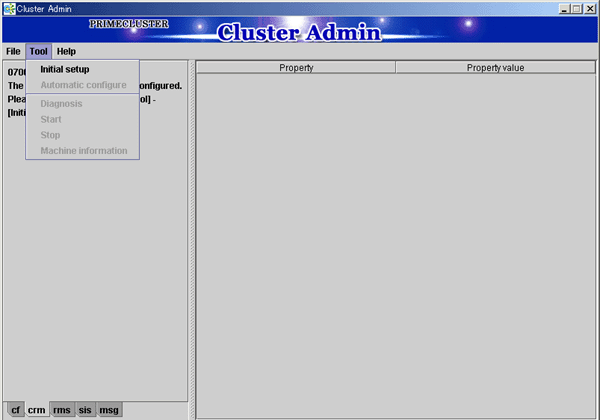
Note
The Initial setup can be selected only if the resource database has not been set.
The screen for initial setup is displayed.
Figure 5.23 Screen for initial setup
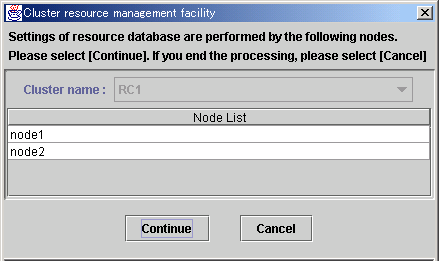
This area displays the names of the clusters that make up the resource database. The cluster names displayed here were defined during CF configuration.
This area displays the list of the nodes that make up the resource database.
Note
Check that the nodes that were configured in the cluster built with CF and the nodes displayed here are the same.
If the nodes do not match, check the following:
Whether all nodes displayed by selecting the cf tab in the Cluster Admin screen are Up.
Whether Web-Based Admin View is operating in all nodes.
For instructions on checking this, see "4.2.3.2 Confirming Web-Based Admin View Startup".
Click this button to set up the resource database for the displayed cluster.
Initial setup is executed on all nodes displayed in the Node list.
Click this button to cancel processing and exit the screen.
Check the displayed contents, and click the Continue to start initial setup.
The screen below is displayed during execution of initial setup.

When initial setup ends, the following message is displayed.
If Ok is selected, the automatic configure screen is displayed. For details on automatic configure, see "5.1.3.2 Automatic Configure".
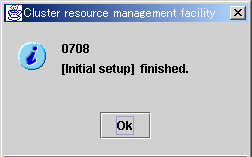
Note
If a message appears during operation at the CRM main window, or if a message dialog box entitled "Cluster resource management facility" appears, refer to the following:
"PRIMECLUSTER Cluster Foundation (CF) Configuration and Administration Guide"
"11.10 Resource Database messages"
Appendix D in this manual
If you want to add, delete, or rename a disk class from the Global Disk Services screen after executing Initial Setup from the CRM main window, close the Cluster Admin screen.
The automatic configure process registers the connected hardware devices (shared disks, line switching units, and network interface cards) to the resource database.
Operation Procedure
Display the automatic configure screen by one of the following methods:
Respond to the "0708 [Initial setup] finished." message, which is displayed after initial setup is completed.
Select Tool -> Automatic configure from the CRM tree view on the CRM main window of Cluster Admin while the cluster name displayed at the highest level is selected.
Figure 5.24 Screen for automatic configure
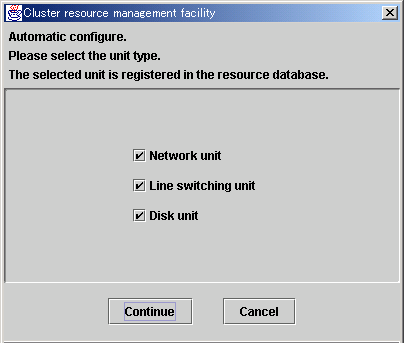
Select this item to detect network interfaces automatically and register them to the resource database.
You must select this item to use public LAN takeover.
Select this item to detect connected line switching units automatically and register them to the resource database.
You must select this item to use the line takeover function.
Do not select this item in an Oracle Solaris 11 environment.
Select this item to detect connected shared disk units automatically and register them to the resource database. You must select this item to use system disk mirroring or to use Global Disk Services (GDS) and Global File Services (GFS) in shared disk unit takeover.
Note
When you use the multipath disk control function to set shared disk units, the following messages may be displayed on the console, depending on the configuration:
WARNING: mphd2048: paths setup information of command is reverse against device one. WARNING: mphd2049: paths setup information of command is reverse against device one.
These messages indicate that connection of multipath disk that is stored in multipath disk control and actual connection of multipath disk are not identical. But multipath disk control automatically reconfigures the multipath according to the actual connection. You can ignore these messages.
When specifying a shared disk unit as the hardware for the patrol diagnosis, set up the physical disk name (such as c1t4d0) of a shared disk unit to be the same in all nodes, and then execute the automatic configuration. When the physical disk name of a shared disk unit varies depending on a node, you cannot set a shared disk unit to the hardware for the patrol diagnosis.
Click this button to detect the selected device type automatically and register it to the resource database.
Click this button to cancel processing and exit the screen.
Select the device type, and click the Continue.
Processing is executed according to the following flow:


When automatic configure is completed, the following message is displayed:
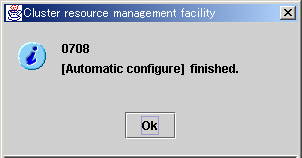
When the initial setup and automatic configure are completed, the following screen appears.
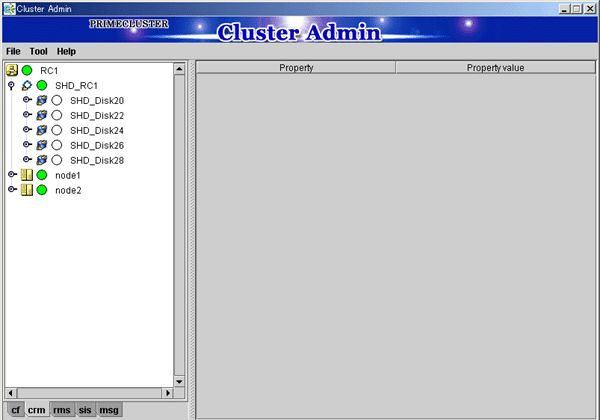
When automatic configuration is completed, go to the CRM main window and confirm that the resource registration is completed by checking the following.
Whether the number of shared disk unit resources is less than the actual device configuration.
Whether any disks other than shared disk unit are registered as shared disk unit.
Whether the number of public LAN resources is less than the actual device configuration.
Whether all connected line switching units are displayed.
If the actual device configuration and the resources do not match each other as described above, automatic detection may have been disabled because of one of the following causes:
There is a connection path failure between a host device and a disk array unit.
A disk array unit is not ready.
A network adapter failed.
A network adapter driver failed.
A line switching unit is not connected properly.
A line switching unit is not turned on.
If the resources are not registered correctly, first review the above causes. Then in the CRM main window, select the Automatic configure in the Tool to re-register the resources.
Note
If a message is displayed in the CRM main window during operation or a message is displayed in the message dialog box entitled "Cluster resource management facility," see the following manuals for details:
"PRIMECLUSTER Cluster Foundation (CF) Configuration and Administration Guide"
"11.10 Resource Database messages"
Appendix D in this manual
If you want to add, delete, or rename a disk class from the Global Disk Services screen after executing automatic configuration from the CRM main window, close the Cluster Admin screen.
The following message may be displayed on the console during automatic configuration:
FJSVcluster: Error: dcmevmd: 6000: An internal error occurred. (function:_evm_res_all_callback detail:0x9060b00-0x4-0-0)
If this message is displayed, all the hardware devices registered to the resource database may not be displayed on the CRM tree view on the CRM main window. Restart the Cluster Admin screen and open the CRM main window again.